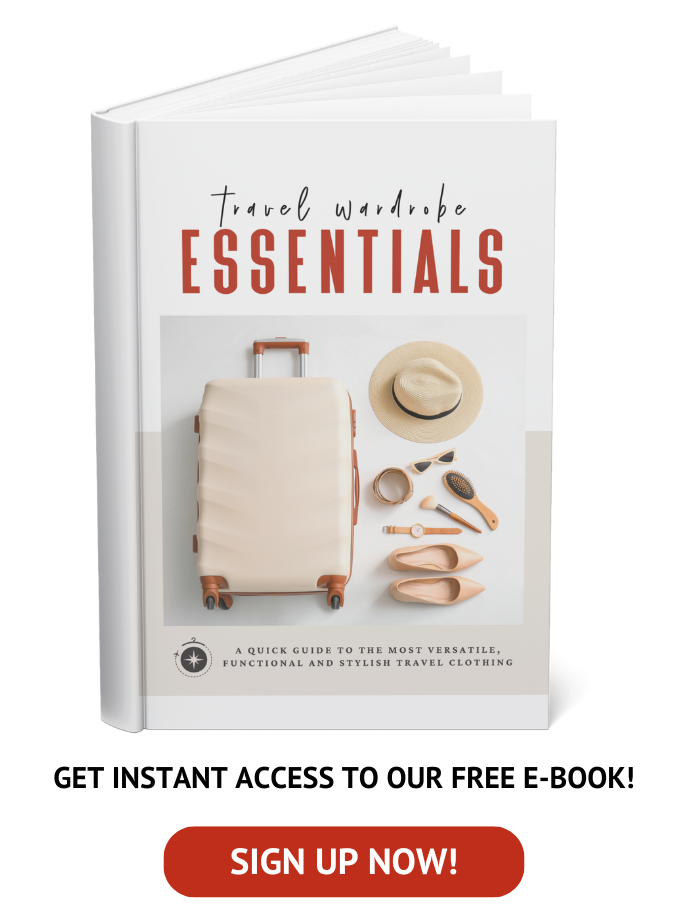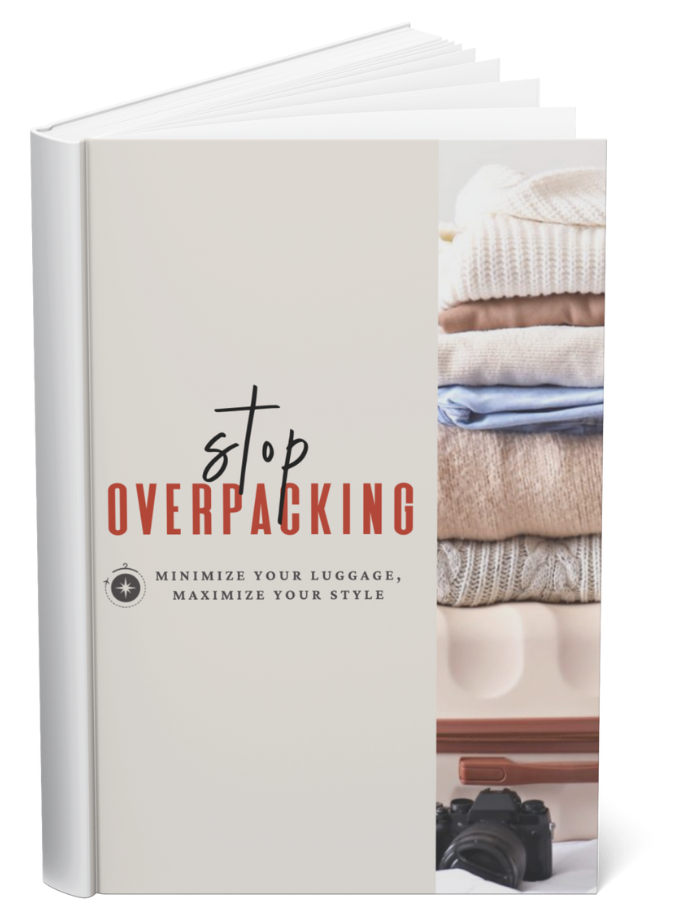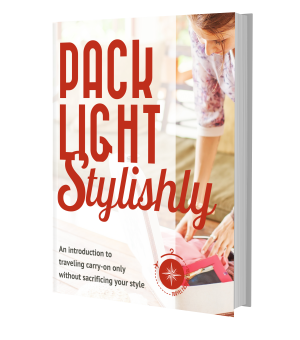10 STEPS TO PACKING FOR SOUTH AMERICA
To help simplify the packing process, we’ve created this 10 step packing guide for a trip to South America. Make this your first stop
when planning your next trip. And don’t forget to download your free packing checklist!
What Do I Pack for South America?
Planning a trip to South America can be the dream of a lifetime until you realize you need to plan what to wear. Don’t stress! We’ve put together all the best tips from the entire blog so you can easily access everything in one easy location. Follow these tips for stress free packing for your dream trip:
STEP 1
South America is a beautifully diverse continent with amazing sites to see, from the high altitudes of Peru and Machu Picchu, to the national parks of Chile, to the city life of Buenos Aires.
Generally speaking, South American style is similar to what you’d wear at home especially when visiting major cities such as Rio de Janeiro, Santiago, or Lima.
The main thing that will affect your packing will be your activities. In this case, you’ll need to bring clothing that’s not just city smart but also outdoor appropriate.
Backpacking South America is an incredible experience for any traveler seeking adventure! Read our complete women’s packing guide to find out what to pack.
Similar to Southeast Asia, backpackers or long-term travelers tend to adopt an extremely relaxed style featuring fisherman style pants and vests. However, this is not typically what locals wear (in either location).
A capsule wardrobe is an essential concept to understand in order to create a minimal yet highly functional (and fashionable) travel wardrobe. Read this packing ebook to help you create the perfect travel wardrobe for your trip.
If you feel extremely overwhelmed at the idea of packing light or have a complicated itinerary, review this packing course which shows you specific techniques to plan around limited clothing choices, varying climates, and other unexpected life situations.
STEP 2
Check weather.com’s extended forecast in advance and 3 days before you leave. Think about how many days you will be in warm vs cold weather.
The weather will also be a major factor in how you pack for a trip to South America. Countries above the equator experience summer in the months of June through August and the ones below the equator feel the highest temps from November to January.
No matter what time of year you visit you’re sure to encounter some cold destinations due to the altitude of countries such as Peru, Bolivia, or Ecuador, not to mention Patagonia, which can be the coldest in the region.
However, even if you plan on spending a large amount of time in the great outdoors hiking Machu Picchu, traversing the Salt Flats, or viewing Iguazu Falls, there’s no need to pack utilitarian tech travel clothing.
Find a balance between clothing items you’d wear at home and athletic clothes that are practical for your outdoor activities as well.
Use our South America packing lists to find clothing ideas to dress appropriately for your destination then use the guidelines from TFG’s Signature Packing Lists to help you customize your travel wardrobe.
If you don’t see your destination listed, post a question on TFG’s Facebook Group.
STEP 3
Because of the variations in weather, you’re most likely going to need to pack both summer and winter clothing in just one trip.
The guides below offer tips on how to do that most effectively:
- Round the World Trip Packing List
- How to Choose Travel Clothing
- The Ultimate Packing Guide for Mixed Weather Trips
- Choosing Shoes for Mixed Weather Trips
If it’s your first time traveling or if you struggle with overpacking, review this packing course which shows you specific techniques to plan for an efficient and highly functional travel wardrobe for any trip.
If you have a complicated itinerary or a trip to countries with varying weather, you might particularly benefit from reading the course.
Tip: Versatile dresses are the best for mixed weather travel – find out why!
STEP 4
There are certain travel items that are necessary on most South America trips whether you’re traveling for the long-term or visiting for a short vacation.
You will need some type of jacket when you go to South America. The type depends on the destination and activities but know that you will need a couple of warm layers to keep you warm as countries are big and the topography varies.
If you’re traveling in the rainy season or have any type of outdoor activity planned you will definitely want a waterproof jacket. If you’re visiting in the winter you’ll also want to bring a down jacket with you.
Choose from our round up of the best down jackets!
STEP 5
When it’s cool and you’re not hiking, camping, or doing any other outdoor activities, jeans will be the best travel pants.
Bring your favorite pair of jeans. As jeans are ultra versatile, you don’t need to pack more than one pair. Not only are they warm and durable, but they’re also normal clothing, which is key to being a happy and comfortable traveler. You want to love the things you wear on the road.
Plus, there are plenty of local laundry services to wash your jeans when you finally do clean them. Otherwise, you don’t need to wash them very often. That’s what the biggest denim designers say, and we agree!
No South America trip is complete without some type of outdoor exploration. Unless you’re planning to visit Patagonia or Machu Picchu, bring at least one or two interchangeable athletic outfits.
These can include workout clothes or tech travel clothing. The most important thing is that the items are quick drying and can be worn repeatedly without the need to wash them too often.
A good example of versatile athletic clothing would be Zella leggings, Lululemon fleece jackets, Nike quick-dry running shorts, or basic Champion workout tops. The key is to choose neutral colors and avoid logos so you can wear them as regular clothing, too.
These are our favorite travel clothing brands that provide a balance of things you’d want to wear at home and on the road, too.
One unexpected issue that many travelers discover once they get to South America is the need for normal clothing. Unless you plan to camp and hike 100% off the time, the majority of your items should be clothing you’d wear at home for a regular day.
And please don’t fall into the trap of bringing things you don’t really like or can give away at the end of your trip. Trust us. You’ll probably want to give away brand new clothes by the time you leave South America.
The key to being happy with a limited wardrobe is to pack clothing you love to wear. Remember, locals do their best to look their best, so why shouldn’t you?
STEP 6
Picking the best shoes for travel to Europe will be one of your biggest challenges so start by reading this 10 step guide to packing the best travel shoes for any trip.
South America is very diverse. Unless you’re staying put in one city, you’ll potentially experience the cosmopolitan city, the sandy beaches, the rough terrain of the national parks, and the wet rainforests.
Bring no more than three pairs opting for shoes that match all your clothing. Pack one pair for sightseeing (walking), one pair of any special activities you have planned, and then a third pair to either dress up your outfits or one that’s appropriate for a change in weather.
These are the best shoes for sightseeing in the cold and these are the best shoes for sightseeing in the heat. Black ankle boots like these are the most recommended shoes when dealing with either cold or mixed weather. For the beach, a pair of flip flops will work. They’re small and easy to pack.
If you are planning on doing a lot of hiking then we’d recommend bringing your own hiking shoes with you like these, especially for the Inca Trail.
Please note: ballet flats are a popular travel shoe option when you want a dressier look but they are NOT recommended for long hours on your feet sightseeing.
Choose one of these cute and comfortable walking shoes instead – they’re the options most recommended by our readers!
For more details, read this guide on choosing travel shoes.
STEP 7
So the hard part’s out of the way; after much turmoil you’ve finally perfected your travel wardrobe and created a chic capsule collection – now it’s time to get packing! Which luggage will work best for you?
Start with luggage. If you don’t already own a suitcase, choose one wisely. Read these tips on how to pick a suitcase and consider one of these top brands. Make your life easy with our best suitcase recommendations.
There are times when backpacks are better than wheeled bags. If you’re going on an adventurous trip, learn how to choose the best travel backpack.
As you’re headed to South America, keep in mind that many international budget airlines have a carryon bag allowance of 55cm x 40cm x 20cm. Check your airline’s individual baggage rules and regulations in advance.
Use packing organizers. Do you want to know the ultimate tool to travel in a carryon? PACKING CUBES! They changed everything for me and thousands of other travelers. See my packing tutorial on how to use them! Trust me, they are a must!
Use tried and tested packing strategies. For a summary, read our top 75 packing tips.
I’ve recently taken on a few extreme packing challenges to show you that packing carry-on only is possible for any trip. If I can pack like an ultra-minimalist (with style of course) then you can pack more comfortably in a regular carry-on. Watch these packing videos to learn more:
Watch all my packing videos here!
STEP 8
The biggest mistake travelers make with toiletries is not considering how much product they actually use. There are five key steps when it comes to downsizing your toiletries properly for a trip:
- Find combination items. You can find two-in-one shampoos and conditioners, body cleanser that can double as shave gel, a foldable brush with a mirror attached on the handle, and multi-use makeup products.
- Purchase empty containers of various shapes and sizes and DO NOT default to choosing “travel size 100ml or 3oz” options. These are the best travel containers.
- Stick to the basics. Simplify your skincare and pampering routine and bring a capsule makeup collection. It’s only temporary.
- Replace liquid beauty products with solids. While solid toiletries may not help you downsize they will help you meet the carryon 3-1-1 liquids rule.
- Choose the right toiletry bag. These are the best toiletry bags and these are the best hanging toiletry bags.
For useful tips such as downsizing toiletries and choosing the best travel makeup, read our Ultimate Guide to Packing Toiletries. It includes a free printable checklist!
While you can buy basic toiletries such as shampoo and moisturizer at your destination, sunscreen is more expensive here and you will definitely need it!
Burns are extremely common due to the proximity of certain destinations to the equator. Plus, the high altitude will increase the severity of the burn if you’re not careful.
Don’t let those cool Andes temperatures trick you. You’re at a higher elevation and even if you’ve don’t tend to burn, you will here! For additional protection, wear a hat and sunglasses.
STEP 9
Don’t forget about safety: Be cautious about where you stash your cash. The safest place for your passport is locked in your accommodation. Carry a photocopy or other ID when you’re sightseeing or are out at night.
Research local scams online, lock your doors when using taxis, and never leave your valuables unattended – especially on long haul buses. If you put your main bag under the bus, do not pack any valuables in there and always lock your bag!
These are articles with other suggested anti-theft products:
- Money Belts and Anti-Theft Accessories
- Best Anti-Theft Bags for Women
- Are these Safe Travel Items Worth Taking
- How I Could’ve Avoided Having May Purse Stolen
Read these tips on how to keep your passport safe when you travel!
Travel Insurance:
If you’re on a long trip, then you should for sure fork out the cash for travel insurance – especially if you plan on participating in outdoor activities that may require airlifting in case of an evacuation. It can happen.
For travel, I recommend Travel Guard, which saved me over $800 in hospital bills on my round-the-world trip. As a scuba diver, I also recommend using DAN, which helped me rearrange my and my husband’s flights at no extra cost when we had a dive incident.
STEP 10
Sign up for Travel Fashion Girl’s monthly newsletter and get instant access to free packing templates, downloadable checklists, ebooks, and more!
BONUS: SOUTH AMERICA TRAVEL TIPS
Remember, South America is a large continent. While there are many similarities within the countries, you should still be aware of the things you need for your individual trips.
Aside from reading Wikitravel and travel blogs, we still believe in a good old-fashioned travel guide for maps, suggested itineraries, local history, basic language phrases, and other practicalities.
Your can download any of the below guides as ebooks or buy the print copies.
These are a few popular South America guidebooks:
- Lonely Planet South America
- Lonely Planet South America on a Shoestring (for budget travelers)
Accommodation
If you’re traveling alone, stay at a hostel to meet other people and enjoy a sociable travel experience. Book using Hostelworld or Hostelbookers. (Tip: hang out in the common room and get your head out of your device. Strike up a conversation with another traveler!)
If you’re traveling as a couple or as a family, save money by staying at guest houses or using Airbnb. For a more sociable experience, opt for a private room in a hostel to meet other people.
For hotels, I use Booking.com to search the best deals. If you book through Hotels.com, you can get a free night for every ten you purchase.
Transportation
There are seemingly countless ways to travel around South America. For land travel, buses are the most popular and readily available option. You can travel by bus pretty much anywhere. It’s also a lot less expensive than air travel, which is still pretty pricey from country to country.
Unless you’re a seasoned international driver, avoid renting a car and driving. Many of the roads are not in the best condition and they can be difficult to navigate.
Money
To get the best exchange rate when I travel I pull money out at ATM machines and use xe.com for currency exchange rate information. Download their app for money updates on the go. Here are tips on how to exchange foreign currency.
Suggested Itineraries
You can find suggested travel itineraries for South America here.
More 10 Step Packing Guides:
EUROPE
PARIS
ITALY
PARIS AND ITALY
SOUTHEAST ASIA
WEATHER
SHOES
ANY TRIP
AVOID OVERPACKING
LIVING ABROAD
WEEKEND BREAK
VACATION
LONG TRIP
LONDON
More Resources:
GETTING STARTED PAGE
FACEBOOK COMMUNITY
PACKING VIDEOS
TFG PINTEREST
WHERE TO SHOP
LIKED THIS POST? PIN THIS PIC TO SAVE IT!










